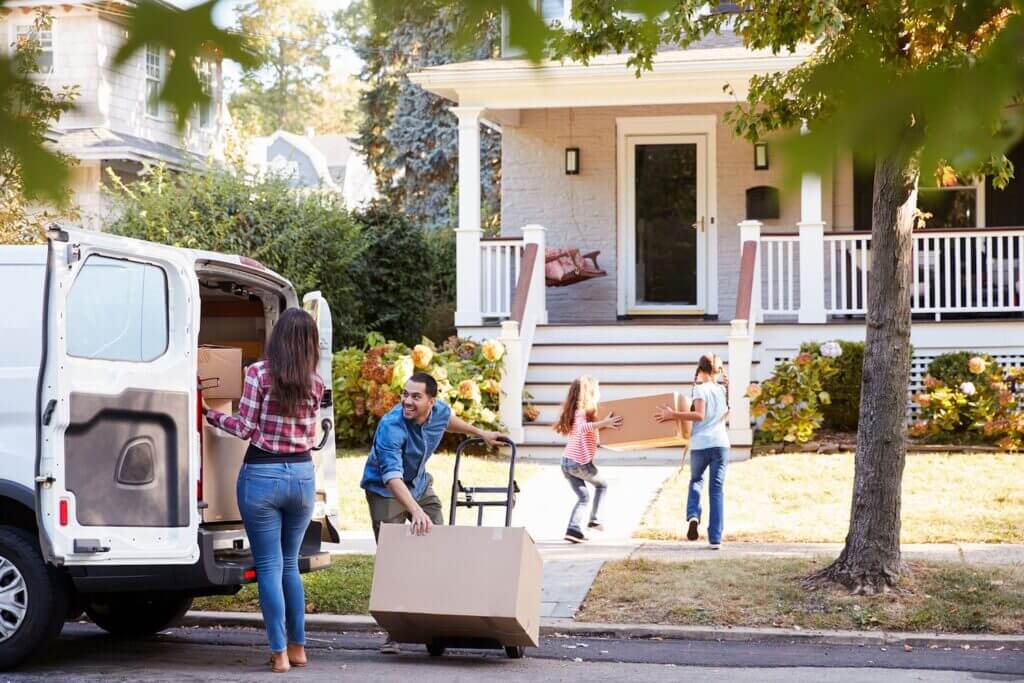Are you moving into a new house soon? It’s an exciting journey to restart your life within the walls of a new space. But, getting there is a lot of work, and that likely has you quite anxious. You need to set up utilities, enroll your children into a new school, find a healthcare provider closer to your new home, pack everything up, find a truck to transport all the furniture, and so many other things, all of which are making you a nervous mess.
Don’t worry — below, you’ll find a detailed checklist that covers all the essential aspects that come with moving into a new space. This checklist is meant as a roadmap to track your progress and ensure your life can go on uninterrupted in your new home.
Checklist for moving into a new home: What to do before the move
There are task list you need to take care of before moving into the new house. The earlier you get these out of the way, the smoother your move-in will go.
1. Research and request quote from moving companies
Reputable moving companies can make even the most complicated relocations seem like a piece of cake. But pick the wrong company, and your moving experience will be 10X harder than it already is.
We recommend researching and getting quotes from at least 3 firms before deciding on one. This is a good range to score the best quality of service for an unbeatable price. Some of the questions you should consider asking the moving company includes:
- What services do you provide?
- Are you licensed & insured?
- How do you typically charge your customers?
- How do you figure out the moving cost?
- Are there any additional fees I should know about?
- How many years have you been in business?
- Would I receive any documentation (contract, itinerary) before the moving day?
- How long would it take to transport the items to my new home?
Also, don’t forget to check the reviews of each company. Reading about the experience of their past customers should give you a good idea about what to expect if you choose to hire them for your move.
2. Research and enroll children in school
If you’re moving to another city or state, you’ll have to enroll your children in a new school district. If you’re moving locally, we recommend driving to your new neighborhood and visiting all the nearby schools in person. Schools often offer campus tours and informational events for prospective students. Taking advantage of these will help you get a better idea of the strengths and weaknesses of each school and all the different programs and extracurricular activities they offer.
If you are moving to another state, then we recommend using online tools like GreatSchools.org, Schooldigger, National Center for Education, and Ratemyteacher.com to find more information about different schools.
You can also gain a wealth of information about the school district through your real estate agent. Ask them for a list of the best schools within the area you’re moving to.
Another point to keep in mind is official school records. You can either ask the current school to give you a copy of all vital paperwork or have them mail it to the new school. The required documents include a sealed transcript, a list of schools your child has attended, immunization record, official test scores, report cards, course outlines, letters of recommendations, work sample, volunteer experience, a list of extracurricular activities, and academic awards.
3. Transfer utilities
Depending on where your new home is located, your current provider may or may not provide coverage for that area. The best thing for you to do is search up the Internet utility companies in your new location for services such as garbage pick up, water, electricity, sewer, and recycling.
It’s best to set up with your new provider at least 2 to 3 weeks before your actual move-in date. This is especially true if you are moving during the summer months when the providers are busiest. Also, note that your current providers will require at least two weeks’ notice for disconnection. But before calling them to cancel your account, make sure that you have a firm move-in date and move-out date ready.
4. Forward your mail
USPS makes it extremely simple to forward your mail to another address. You can set up your mail forwarding date three months in advance of your move-in date. We suggest doing it as soon as you close on your new home.
Typically mails and packages will be forwarded to your new address for up to 12 months. You can set up forwarding in person or online.
5. Cancel or transfer Internet and cable service
Check to see if your cable and internet provider services your new residence. If yes, then simply call the companies and have them transfer your account to the new address.
If you need to switch to a new provider, set up a time when you’ll be physically available at your new home. You’ll have to let the installer into your property for them to turn on the Internet. And it’s nice to be there so you can test the Internet connection to ensure everything is working well.
6. Get familiar with the local stores
Visit your neighborhood during morning and evening to check out its vibe during both times. Check out the local grocery stores, Farmer’s markets, calendar for community activities like children’s activities, street fairs, and parades.
Also, look up the local cafes, libraries, brunch spots, restaurants, gyms, banks, vet clinics, gas stations, parks, doctor’s offices, and transportation options. With the new location, you will be soon calling home.
7. Brainstorm what you need for the new house
One of the many things that make moving into a new home so exciting is that you get to furnish it any way you want. Your old furniture may no longer suit the aesthetics you’re going for in your new place. We suggest taking an inventory of everything you have and looking at your new house’s floor layout again.
Make a list of what you need to buy for each room. If you need any new furniture, shop, and place an order in advance because it can take weeks to months to receive shipment.
8. Take photos of everything valuable in your home
This is highly crucial if you will be having people, such as cleaners and movers going in and out of your house. Take a picture of expensive items such as furniture, piano, jewelry, electronics, anything breakable for your records.
The main reason for taking pics is that no matter how skilled the handlers are, accidents can still happen. If anything goes missing or gets damaged by the handlers, you’ll have proof when asking for reimbursement.
9. Hire professional cleaners
Before you move furniture into your new house, it’s best to have it thoroughly cleaned at least once. If you hire professional cleaners, the whole process shouldn’t take more than a day or two. If you decide to do it yourself, it may take longer, so start early.
Here are some places you’d want to be cleaned:
- Kitchen: Oven, sink, cabinets, countertops, refrigerator (don’t forget to get the wall behind it as well)
- Bathroom: Sink, mirrors, tub, toilet, showerhead, light bulbs and fixtures, shower drains, air vents, faucet, curtains, window screens, drawers, exposed plumbing
- Floors and walls: Using a steam cleaner will help get rid of tough stains and pet odors. When it comes to walls, use vinegar and water to wash them and get rid of tough stains, cobwebs, dirt, etc. Use a scrub if necessary.
10. Get the necessary home improvements done
Got broken plumbing, carpet stains, faulty locks, holes on the walls, water damage on ceilings of your new home? Have these taken care of by the previous owner or property management team before move-in. If you decide to do some repairs or renovate certain sections, change the flooring, or just want the walls painted, try to take care of it all in advance before the furniture gets moved in.
11. Start the packing process
Even if you are hiring professional movers, you need to sort your items, decide what you’re taking and what you plan to donate or throw. Keep the layout of your new home in mind when going through your items. You want to make sure there will be enough space for everything you’re taking with you.
If you’re packing yourself, this is when you want to order your moving supplies like boxes, moving tapes, bubble wraps, packing paper, etc. We recommend going to Craigslist, local stores, and recycling centers to see if you can find moving boxes for free.
12. Prepare an essentials box
Each family member should have an essential box containing items needed to get through the first few nights. These include bedding, pillow, spare clothes, toiletries, toothbrushes, toothpaste, medications, chargers, laptops, etc.
Even if your items take a little longer to be delivered due to some unforeseen circumstance beyond your and the moving companies’ control, this essential box will keep everything covered.
13. Take important documents with you
It’s best to take sensitive documents like social security, passport, birth certificates, diplomas, school and medical records, and insurance policies.
Checklist for moving into a new house: What to do after the move
Now you’re in your house with all your belongings surrounding you, but still inside boxes. Here is what you need to do next. Remember that there’s no hurry. Since you’re in your new home, you can take days, weeks, or even months to complete these tasks — whatever your schedule permits.
1. Disinfect your new home
You’ve already done the deep cleaning before moving in. But, it’s always good to clean one more time since you had movers working on your property. Deep cleaning won’t be necessary. Just wipe down all the counters and floors to get rid of any dust and debris.
2. Arrange your furniture
If you hire movers, they’ll place the furniture where asked. This way, you won’t need to handle lifting or dragging the heavy items yourself and risk hurting yourself and the floors. The movers will also reassemble everything, like beds and couches, for you.
If doing it yourself, have a concrete idea of where you want everything. This way, you won’t have to spend time and energy constantly rearranging things.
Get the beds, and major furniture pieces arranged and set up first, then move on to unpacking essential items needed in central parts of the house, like bathrooms and kitchen. Unpack clothing, books, records, and other Knick-knacks as you find the time.
3. Rekey for security
Another important checklist item for moving is to change the locks during the first few days after moving. Changing locks is vital because you can’t be entirely sure who has access to your property. The previous owner might have given duplicates to their family, former spouse, friends, etc. Rekeying is a one-time expense, and it will provide you with peace of mind knowing there won’t be any stranger coming into your property.
4. Locate your home’s main water shut-off valve
It’s essential to know where your home’s main water supply valve is located and how to turn it off. During a plumbing project, or during emergencies (ruptured water line, pipe bursts, broken or damaged valve), you’ll have to turn off this valve. It is usually located near the water meter. But some might be inside the house or near the property line.
5. Locate the circuit-breaker
Sometimes, you may have to replace a fuse or reset a switch during a power outage or other emergencies. So it’s essential to know its location in advance. Your home’s circuit breaker has several controls labeled by rooms. It’s usually located in low-traffic areas such as the garage, basement, or utility closet. You will find them as a metal box traditionally flushed against a wall.
6. Set up your home security system
Your home may already have an existing alarm system. Research what type of system is already installed, and Google search its features. If it doesn’t offer the capabilities you’re looking for, then shop around for a new one. It’s always good to find a local alarm company since they know your area the best.
7. Plan for a lock-up situation
It happens to the best of us — misplaced or forgotten keys can get you locked out of your own home. Or, maybe your family members are sleeping or in the shower and don’t hear the doorbell, so you’re stuck outside in the rain. Have a backup plan if you get locked out of your home. You may have to call your locksmith. Have your neighbor’s phone number on hand if your children have trouble getting inside the house due to forgetting keys and you’re stuck at work.
8. Ensure your smoke detectors are working
Test your smoke detectors to see if they will function during an emergency or if they need to be replaced or repaired. To test, press and hold the test button on the detector for a few seconds. It should produce a loud siren. Make sure your family members can hear it in all rooms.
9. Make sure your HVAC system works
Usually, we only appreciate our HVAC systems during extreme weather conditions, I.e., when it’s too hot or too cold outside. But poor HVAC systems can lower our quality of life and give us health issues. If you think your HVAC system isn’t working correctly, get it repaired or replaced immediately.
10. Create a home maintenance checklist
Having a regular maintenance schedule prevents expensive repairs down the road. Here are some things to maintain:
- Clean furnace filter
- Clean showerheads and faucets to remove mineral deposits
- Clean tub and drains
- Test smoke alarms and carbon monoxide detectors
- Inspect electric cords for wear
- Vacuum heat vents
- Check indoor and outdoor vents for blockage
- Clean garbage disposal
- Seal cracks on windows and walls
- Rake leaves
- Remove leaves and debris from gutters
- Clean carpets and windows
- Prune trees and shrubs
- Clean refrigerator and dishwasher
We hope this checklist for moving into your first house maintains your excitement of starting afresh. Don’t forget to throw a housewarming party at the end. So you and your loved ones can celebrate this momentous point in your life. If you, or anyone you know, needs help moving with local or long distance moves in Boston and throughout the US, don’t hesitate to give us a call. Here is a list of our most popular services:
We are waiting for your calls!


